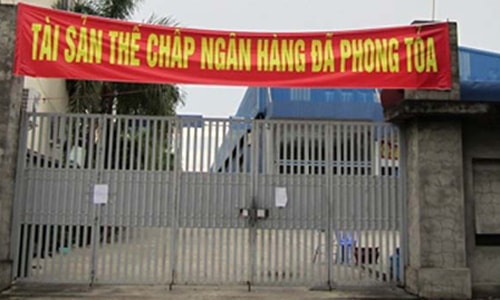Half a million billion dong of bad debt was 'cleared' in 4 years
Nearly half of the 500,000 billion VND of bad debt resolved since 2012 has been through debt sales, while the amount cleared through handling of collateral is less than 1%.
The above information was just announced by Deputy Governor of the State Bank - Nguyen Kim Anh at the Workshop on the right to handle collateral assets of banks held on December 6. Associate Professor, Dr. Nguyen Kim Anh assessed that the banking industry has made efforts to use many measures to handle bad debt in the past 4 years. By the end of 2015, the whole industry had "cleaned up" 493,000 billion VND of bad debt. 55.4% was collected and handled by the banks themselves. The remaining part was sold through the National Debt Trading Company (VAMC) and sold to a number of other organizations and individuals.
 |
Banks are constantly at a loss in recovering collateral that should be theirs after customers default on payments. |
According to Mr. Nguyen Kim Anh, more than 90% of bad debts have collateral, so promoting the sale and auction of these assets needs to be focused on. However, debt recovery through this form has only reached less than 14,000 billion VND, accounting for less than 1% of the bad debts handled.
Dr. Vu Dinh Anh also believes that resolving bad debts through handling collateral assets also contributes to reducing the financial burden of the budget with "blood clots". According to him, banks selling and quickly auctioning collateral assets not only helps to immediately and completely handle a series of bad debts, unblocking credit but also activates a huge amount of assets worth hundreds of thousands of billions of VND that are lying idle. Thanks to that, it increases the supply for the real estate market, finance and even the commodity market.
In fact, many banks say that when customers are unable to pay, it is extremely difficult for banks to carry out procedures to recover and handle secured assets.According to a representative of Vietnam Prosperity Bank (VPBank), the problem lies with many parties, from the application of the law by competent authorities to the process of handling through lawsuits and the execution stage. "The viewpoint of building and enforcing the law needs to be changed, that is, the first priority must be to protect the rights of creditors instead of debtors, that is, to protect the full ownership of the loaned money, instead of protecting the limited ownership of the borrowed money or assets that have been used as security for debt repayment obligations," said a representative of this bank.
Similarly, a representative of the Vietnam Technological and Commercial Joint Stock Bank (Techcombank) also said that debt settlement is slow or delayed due to complicated and lengthy litigation and enforcement procedures. "Therefore, many customers who want to delay debt repayment have used this procedure to request the bank to resolve the dispute through the court to delay the settlement," he said.
Another speaker also cited figures from the World Bank’s Doing Business 2017 Report to show that the process of resolving collateral through the court is very thorny. Accordingly, the average time to resolve disputes in Vietnam through the court is 400 days, with a cost of 29% of the debt value. Vietnam’s Judicial Proceedings Quality Index is only 6.5 out of 18.
At the same time, a report by the General Department of Civil Judgment Enforcement, Ministry of Justice also showed that in 2016, there were still nearly 16,000 unresolved civil judgment enforcement cases related to bank credit with a total amount of nearly 59,000 billion VND.
According to VNE
| RELATED NEWS |
|---|


